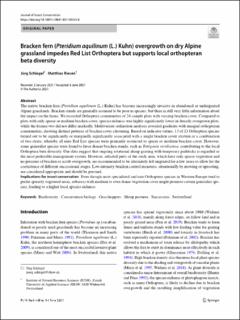Please use this identifier to cite or link to this item:
https://doi.org/10.21256/zhaw-22657Full metadata record
| DC Field | Value | Language |
|---|---|---|
| dc.contributor.author | Schlegel, Jürg | - |
| dc.contributor.author | Riesen, Matthias | - |
| dc.date.accessioned | 2021-06-17T07:51:28Z | - |
| dc.date.available | 2021-06-17T07:51:28Z | - |
| dc.date.issued | 2021-06-14 | - |
| dc.identifier.issn | 1366-638X | de_CH |
| dc.identifier.issn | 1572-9753 | de_CH |
| dc.identifier.uri | https://digitalcollection.zhaw.ch/handle/11475/22657 | - |
| dc.description.abstract | The native bracken fern (Pteridium aquilinum (L.) Kuhn) has become increasingly invasive in abandoned or undergrazed Alpine grasslands. Bracken stands are generally assumed to be poor in species, but there is still very little information about the impact on the fauna. We recorded Orthoptera communities of 24 sample plots with varying bracken cover. Compared to plots with only sparse or medium bracken cover, species richness was highly significantly lower in densely overgrown plots, while the former two did not differ markedly. Multivariate ordination analyses revealed gradients with unequal orthopteran communities, showing distinct patterns of bracken cover clustering. Based on indicator values, 13 of 23 Orthoptera species turned out to be significantly or marginally significantly associated with a single bracken cover stratum or a combination of two strata, whereby all nine Red List species were primarily restricted to sparse or medium bracken cover. However, some generalist species were found to favor denser bracken stands, such as Tettigonia viridissima, contributing to the local Orthoptera beta diversity. Our data suggest that ongoing rotational sheep grazing with temporary paddocks is regarded as the most preferable management system. However, selected parts of the study area, which have only sparse vegetation and no pressure of bracken or scrub overgrowth, are recommended to be alternately left ungrazed for a few years to allow for the coexistence of different successional stages. Low-intensity bracken control measures, situationally by mowing or uprooting, are considered appropriate and should be pursued. Implications for insect conservation: Even though most specialized and rare Orthoptera species in Western Europe tend to prefer sparsely vegetated areas, subareas with medium to even dense vegetation cover might promote certain generalist species, leading to a higher local species richness. | de_CH |
| dc.language.iso | en | de_CH |
| dc.publisher | Springer | de_CH |
| dc.relation.ispartof | Journal of Insect Conservation | de_CH |
| dc.rights | https://creativecommons.org/licenses/by/4.0/ | de_CH |
| dc.subject | Biodiversität | de_CH |
| dc.subject | Heuschrecken | de_CH |
| dc.subject | Sukzession | de_CH |
| dc.subject | Naturschutz | de_CH |
| dc.subject | Beweidung | de_CH |
| dc.subject.ddc | 333.7: Landflächen, Naturerholungsgebiete | de_CH |
| dc.subject.ddc | 590: Tiere (Zoologie) | de_CH |
| dc.title | Bracken fern (Pteridium aquilinum (L.) Kuhn) overgrowth on dry Alpine grassland impedes Red List Orthoptera but supports local orthopteran beta diversity | de_CH |
| dc.type | Beitrag in wissenschaftlicher Zeitschrift | de_CH |
| dcterms.type | Text | de_CH |
| zhaw.departement | Life Sciences und Facility Management | de_CH |
| zhaw.organisationalunit | Institut für Umwelt und Natürliche Ressourcen (IUNR) | de_CH |
| dc.identifier.doi | 10.1007/s10841-021-00333-8 | de_CH |
| dc.identifier.doi | 10.21256/zhaw-22657 | - |
| zhaw.funding.eu | No | de_CH |
| zhaw.issue | 25 | de_CH |
| zhaw.originated.zhaw | Yes | de_CH |
| zhaw.pages.end | 669 | de_CH |
| zhaw.pages.start | 657 | de_CH |
| zhaw.publication.status | publishedVersion | de_CH |
| zhaw.volume | 2021 | de_CH |
| zhaw.publication.review | Peer review (Publikation) | de_CH |
| zhaw.webfeed | Umweltplanung | de_CH |
| zhaw.funding.zhaw | Raumnutzung von Tagfaltern und Heuschrecken auf dem Waffenplatz Chur | de_CH |
| zhaw.author.additional | No | de_CH |
| zhaw.display.portrait | Yes | de_CH |
| Appears in collections: | Publikationen Life Sciences und Facility Management | |
Files in This Item:
| File | Description | Size | Format | |
|---|---|---|---|---|
| 2021_Schlegel-Riesen_Bracken-fern-overgrowth.pdf | 1.96 MB | Adobe PDF |  View/Open |
Show simple item record
Schlegel, J., & Riesen, M. (2021). Bracken fern (Pteridium aquilinum (L.) Kuhn) overgrowth on dry Alpine grassland impedes Red List Orthoptera but supports local orthopteran beta diversity. Journal of Insect Conservation, 2021(25), 657–669. https://doi.org/10.1007/s10841-021-00333-8
Schlegel, J. and Riesen, M. (2021) ‘Bracken fern (Pteridium aquilinum (L.) Kuhn) overgrowth on dry Alpine grassland impedes Red List Orthoptera but supports local orthopteran beta diversity’, Journal of Insect Conservation, 2021(25), pp. 657–669. Available at: https://doi.org/10.1007/s10841-021-00333-8.
J. Schlegel and M. Riesen, “Bracken fern (Pteridium aquilinum (L.) Kuhn) overgrowth on dry Alpine grassland impedes Red List Orthoptera but supports local orthopteran beta diversity,” Journal of Insect Conservation, vol. 2021, no. 25, pp. 657–669, Jun. 2021, doi: 10.1007/s10841-021-00333-8.
SCHLEGEL, Jürg und Matthias RIESEN, 2021. Bracken fern (Pteridium aquilinum (L.) Kuhn) overgrowth on dry Alpine grassland impedes Red List Orthoptera but supports local orthopteran beta diversity. Journal of Insect Conservation. 14 Juni 2021. Bd. 2021, Nr. 25, S. 657–669. DOI 10.1007/s10841-021-00333-8
Schlegel, Jürg, and Matthias Riesen. 2021. “Bracken Fern (Pteridium Aquilinum (L.) Kuhn) Overgrowth on Dry Alpine Grassland Impedes Red List Orthoptera but Supports Local Orthopteran Beta Diversity.” Journal of Insect Conservation 2021 (25): 657–69. https://doi.org/10.1007/s10841-021-00333-8.
Schlegel, Jürg, and Matthias Riesen. “Bracken Fern (Pteridium Aquilinum (L.) Kuhn) Overgrowth on Dry Alpine Grassland Impedes Red List Orthoptera but Supports Local Orthopteran Beta Diversity.” Journal of Insect Conservation, vol. 2021, no. 25, June 2021, pp. 657–69, https://doi.org/10.1007/s10841-021-00333-8.
Items in DSpace are protected by copyright, with all rights reserved, unless otherwise indicated.